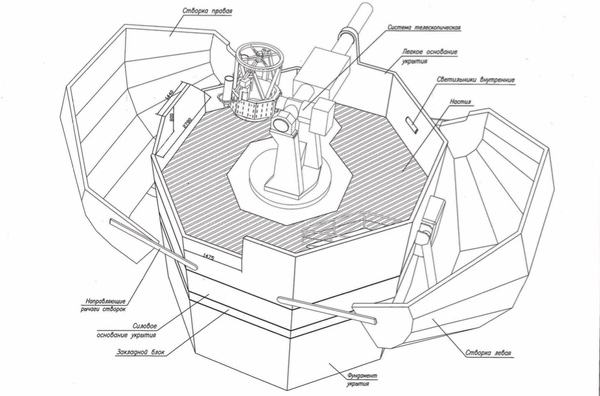Existe una fuerte evidencia de que un complejo de vigilancia espacial en el norte del Cáucaso en Rusia está siendo equipado con un nuevo sistema láser llamado Kalina que apuntará a los sistemas ópticos de satélites de imágenes extranjeros que vuelan sobre territorio ruso. Iniciado en 2011, el proyecto ha sufrido numerosos retrasos, pero las imágenes recientes de Google Earth muestran que la construcción ya está en marcha. Kalina complementará un láser móvil deslumbrante conocido como Peresvet que ha estado operativo desde finales de 2019.
There is strong evidence that a space surveillance complex in Russia’s northern Caucasus is being outfitted with a new laser system called Kalina that will target optical systems of foreign imaging satellites flying over Russian territory. Initiated in 2011, the project has suffered numerous delays, but recent Google Earth imagery shows that construction is now well underway. Kalina will complement a mobile laser dazzler known as Peresvet that has been operational since late 2019.
The Krona space surveillance complex
Kalina is part of the Russian Ministry of Defense’s Krona space surveillance complex, situated several kilometers west of Zelenchukskaya, a place well known in the astronomical community. Also located in its immediate vicinity are the Russian Academy of Science’s Special Astrophysical Observatory (housing the six-meter BTA telescope) and the RATAN-600 radio telescope.
Kalina will complement a mobile laser dazzler known as Peresvet that has been operational since late 2019.
Krona (“tree crown”) consists of a radar system (designated 40Zh6) and a lidar (designated 30Zh6), which are several kilometers apart. The lidar (literally referred to in Russian as a “laser optical locator” or LOL) is situated on top of a two-kilometer-high mountain called Chapal (its exact coordinates being 43°43’2″N, 41°13’41″E). Krona was conceived back in the mid-1970s (among other things to provide targeting data for Soviet anti-satellite systems), but didn’t become operational until early this century. The radar system is mainly intended to furnish LOL with accurate trajectory data to point its telescopes at targets of interest.

LOL comprises a 1.3-meter narrow-angle telescope with adaptive optics for high-resolution imaging of satellites in low orbits and a 0.4-meter wide-angle telescope for the detection of satellites in high orbits. Together these are known as the “passive channel”. Housed in an adjacent building is a lidar, also called the “transmit/receive channel”. This consists of a laser attached to a 1.3-meter telescope and its purpose is twofold: it can accurately measure the distance to satellites as well as illuminate satellites at any time of the day for photography.
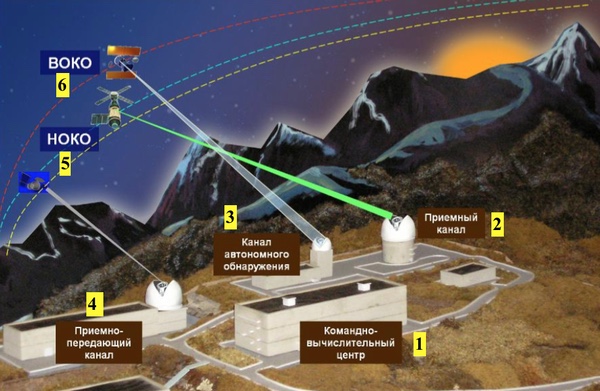
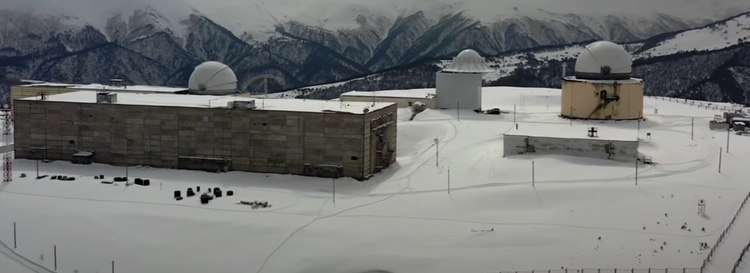
Kalina’s counterspace role
Early last decade work got underway on expanding LOL with a new laser system called Kalina (“guelder rose”). Its existence can only be inferred from a number of online procurement and court documents, which in turn make it possible to find several technical publications that are most likely related to the project.
The project officially began on November 3, 2011, with a contract awarded by the Ministry of Defense to the Moscow-based Scientific and Industrial Corporation “Precision Instrument Systems” (NPK SPP), the prime contractor for Krona’s LOL complex. The Ministry of Defense had approved technical specifications for the project on April 28, 2011.[1] However, preliminary research for the project seems to have started well ahead of this. Kalina is first seen in a PhD dissertation published in 2002 as the name of a research project conducted for NPK SPP by an institute belonging to the Ministry of Defense. It focused in particular on adaptive optics systems for large telescopes to compensate for distortions caused by the atmosphere and the telescopes themselves.[2]
Evidence for Kalina’s counterspace role comes from three independent sources. First, a bank guarantee document placed online in January 2014 said Kalina’s goal was the creation of a system for the “functional suppression” of electro-optical systems of satellites with the help of solid-state lasers and a transmit/receive adaptive optics system.[3] Second, a document that appeared online in 2017 with a list of planned military building projects characterized Kalina as a “space security complex”, a term also used in the same document and several others for an air-launched anti-satellite system known as Burevestnik.[4] Finally, NPK SPP’s annual report for 2013 (one of only two available online) acknowledged its involvement in the development of what it called “laser systems for electro-optical warfare”. It described Kalina as a “special quantum-optical system”, using the same term for a system “with similar characteristics and purpose” being developed by the Rosatom state corporation, most likely Peresvet.[5]
Several documents refer to Kalina as 30Zh6MK (30Ж6МК in Cyrillic letters). 30Zh6 was the original index for LOL, with the letter “M” added after a modernization of the observatory. The “K” presumably stands for Kalina. A handful of court documents related to Kalina mention something called “channel 14Ts235” (14Ц235 in Cyrillic letters), apparently yet another index for the system.[6].
Progress on Kalina over the past decade has clearly been slow.
Procurement documents make it possible to identify Kalina’s chief designer as Aleksandr B. Aleksandrov, who headed a major laser test center (GLP Raduga near Vladimir, some 200 kilometers east of Moscow) from 2004 until 2009 before becoming a deputy general designer at NPK SPP. Articles written by Aleksandrov show that he had been involved in research on adaptive optics systems since the 1990s. A person identified in documentation as a “leading designer” of Kalina is Valeri A. Kufterin, another veteran of GLP Raduga. Both Aleksandrov and Kufterin held those positions until at least 2017. Much of the work on Kalina seems to have been done at a branch of NPK SPP in St.-Petersburg specializing in laser systems.
On the very same day that NPK SKK received the contract for Kalina, it was also assigned to a research project named Kern (a word meaning “core sample”). Its purpose was to build an experimental “coherent lidar”, with one aspect of the work being the development of software to process information from synthetic aperture. According to one source, Kern was intended to study lidars using the principle of heterodyne detection, a technique that makes it possible to obtain high-resolution images beyond the diffraction limit of conventional optics. The experimental laser, emitting at wavelengths of either 1.064 or 1.55 microns, was supposed to be aimed at targets during tests at the Raduga laser test center in 2014. Technical specifications for Kern were approved by the Ministry of Defense on the same day as those for Kalina (April 28, 2011) and the project was also headed by Aleksandrov.[7] Possibly, Kern was a technology demonstrator for Kalina, but a firm link between the two projects cannot be established.
Kalina’s design features
Progress on Kalina over the past decade has clearly been slow. A newsletter published by NPK SPP in late 2016 acknowledged the numerous delays experienced by the project.[8] At least two building contracts for Kalina were awarded by the Ministry of Defense, one on November 20, 2015, and another on June 1, 2018, with the construction site being labeled “4737-K2”.[9]
The first signs of groundbreaking work at the site are seen in Google Earth imagery from August 2019. By September 2020, construction work was clearly underway just south of the lidar building.
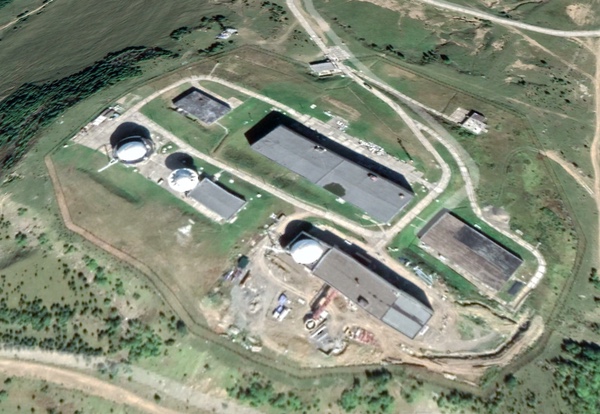
The most recent imagery of the site is from March this year, when it was still covered in snow. A new telescope dome has now appeared at this location, connected to the lidar building by a tunnel.
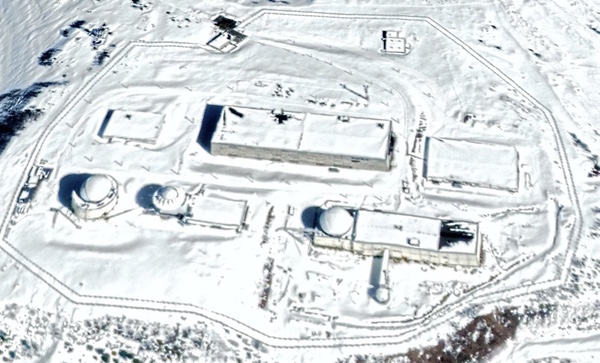
This is a close-up of the new infrastructure.
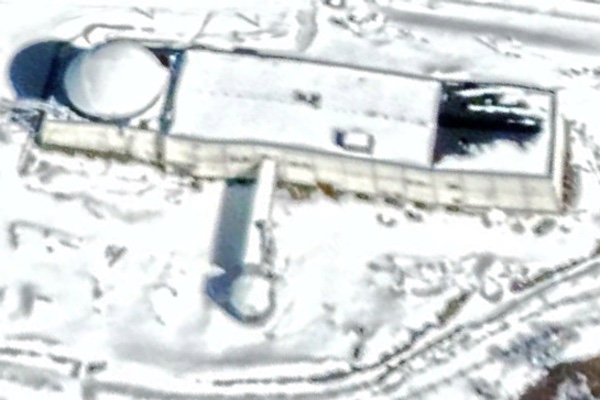
Since there is no evidence for any other planned construction work at the site, the new infrastructure is most likely part of Kalina. What is seen in the imagery is also consistent with the scarce information on Kalina that can be extracted from online sources.
Tender documentation placed online in 2015 had already made it clear that Kalina would feature a new telescope to accurately aim laser beams at satellites.[10] The tender was actually for the construction of the building that would house the telescope. It specifically linked the building to 30Zh6MK, the index for Kalina. Technical specifications summed up in the documentation called for the building (designated 00877S) to be able to operate in temperatures ranging from +40 to -40°C and withstand magnitude 7 earthquakes. It has a base diameter of 7.13 meters and is covered by a dome consisting of two sections that can be opened in less than ten minutes. It allows the telescope to scan the entire sky all the way from the zenith to an elevation of 30°. Drawings included in the documentation show a lightning protection mast on top of the building. This is probably the structure seen in the Google Earth imagery on the interface between the telescope building and the tunnel (a similar structure is right next to the dome of the lidar building).
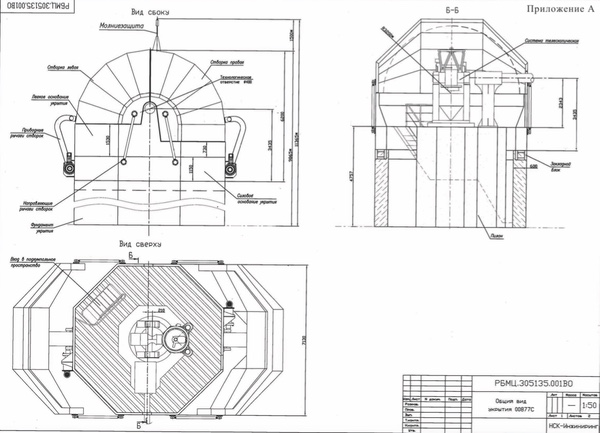
Although the tender documentation did not focus on the telescope itself, it did contain a drawing of the telescope inside the dome (see the drawing heading this article). This shows a mirror telescope mounted on a long boom. On top of the telescope are two optical devices resembling viewfinders.
The optics of the telescope are most likely the subject of a patent co-authored by Kalina chief designer Aleksandr Aleksandrov and an article recently published by NPK SPP, which also includes a schematic representation of the system.[11]
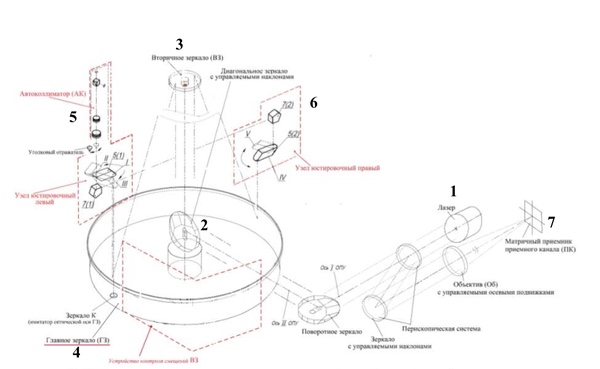
The laser beams are routed to the telescope via a series of mirrors and enter the telescope through a side opening. They are then deflected by a diagonal mirror to a secondary mirror, which in turn sends them to the main mirror. Reflected laser beams follow the opposite route and end up forming an image of the targeted object in a detector (Kalina is a “transmit-receive” system, so it also picks up laser beams reflected back from the target.)
The adaptive optics system (designated F-1040), which is not on the telescope itself, is detailed in procurement documentation published in 2012. Placed in charge of that system was a company named NPTs Femto, based in Zelenograd near Moscow, which has also built adaptive optics systems for the Titov Optical Laser Center (AOLTs) in the Altai mountain range, another element of Russia’s space surveillance network.[12] Like all such systems, it is a combination of instruments (including a deformable mirror, waveguide sensor, and data processing system) to compensate for atmospheric turbulence and thus enhance the resolution of the images. The atmospheric turbulence is probably measured by using laser beams to create an artificial guide star in the vicinity of the targeted object.
Kalina most likely needs the adaptive optics system to produce images of the target that are sharp and detailed enough to make sure that the laser beams can subsequently be accurately aimed at the object’s optical systems. Judging from the 2012 document, this aiming is done manually. It says that an “operator” can simultaneously see the corrected image and the emitted laser beam and then select a spot on the target that needs to be “illuminated”. The system can also be used in daylight by filtering out background light.
Kalina most likely needs the adaptive optics system to produce images of the target that are sharp and detailed enough to make sure that the laser beams can subsequently be accurately aimed at the object’s optical systems.
The two devices on top of the telescope resembling viewfinders are actually autocollimators that are needed to make sure that all the optics are properly aligned to both send and receive the laser beams. Misalignments of the optics can be caused by temperature fluctuations as well as the sheer weight of the telescope structure itself. Using a set of prisms, the autocollimators send pulses of light to smaller “imitating mirrors” aligned with both the primary and secondary mirrors. The obtained measurements are processed in an electronics box (possibly the rectangularly shaped box seen on the telescope boom) and then used to adjust the position of the diagonal and secondary mirrors to ensure that the laser beams reflected off the primary mirror are collimated, that is travel parallel rather than spreading out. Because of this built-in collimation system, the telescope is literally referred to in Russian as a “telescope-collimator” (its index being F-1010.)
In 2015, NPK SPP ordered mirrors for a “telescope-collimator” that very likely is the one for Kalina (the term is rarely seen in Russian technical literature and denotes a very specific telescope design.) Drawings published in the associated tender documentation make it possible to determine that the primary and secondary mirrors have diameters of 1.010 and 0.167 meters respectively.[13]
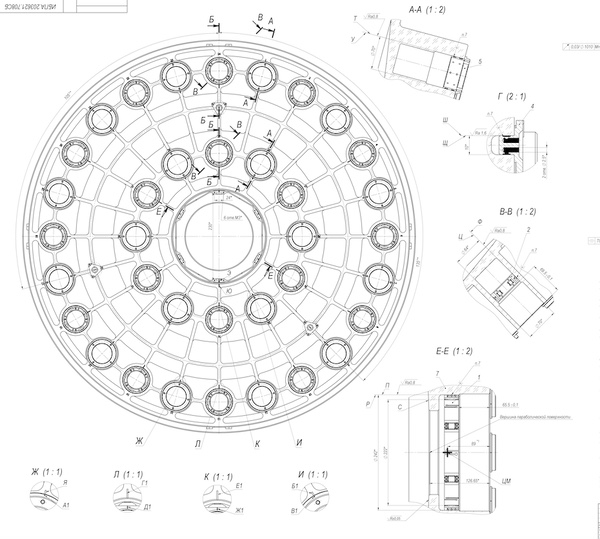
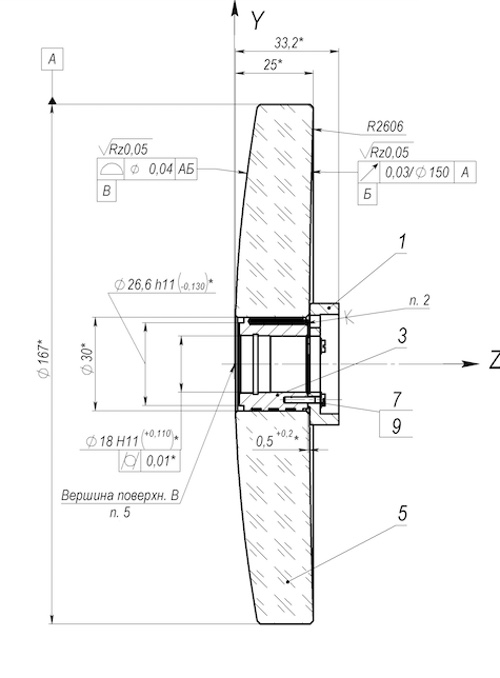
The mirrors were almost certainly built by the Lytkarino Optical Glass Factory (LZOS), which also manufactured the mirrors for LOL’s wide-angle and lidar telescopes. According to two issues of LZOS’s in-house magazine published in 2017 and 2019, the company had produced an experimental version of a large one-meter-diameter reflector telescope that can automatically correct any misalignments of its optical elements caused by changes in temperature or the orientation of the telescope.[14] In 2016, the telescope’s designers (identified by name in the magazine) wrote an article on a one-meter telescope matching the description of Kalina’s. The telescope’s frame would likely be made of carbon fiber composite materials or silicon carbide, which are lighter and less prone to deformation than titanium, the traditionally used material.[15]
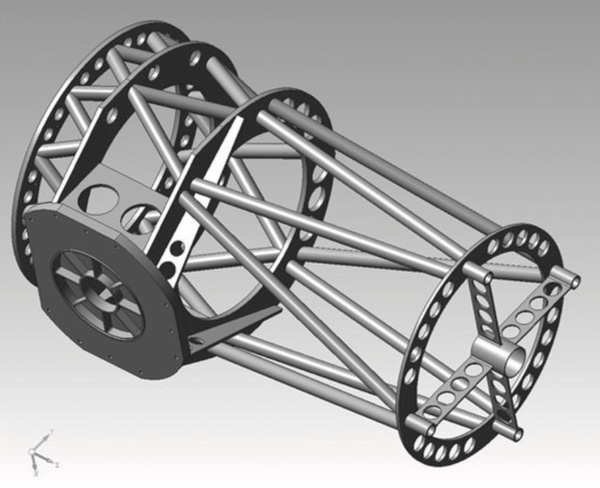
Another element of Kalina mentioned in online documentation is the electric drive mechanism (F-1090) for the telescope mount, produced by University of Information Technologies, Mechanics and Optics (ITMO) in St. Petersburg. ITMO University is also responsible for Kalina’s powerful solid-state laser system, for which it received a contract from NPK SPP on May 2, 2012.[16] A document describing the system needed to route the laser beams to the telescope (known as F-1012) says it has to be capable of transferring laser beams with a wavelength of 1.0645 microns, a power density of 0.1 gigawatts per square centimeter, a pulse length of 10 nanoseconds, and a pulse repetition rate of 3 KHz.[17] Lasers emitting at 1.064 microns (which is in the near infrared) are so-called Nd:YAG lasers, the type most commonly used for rangefinding and target designation.
The lasers and associated systems are installed in the adjacent lidar building and the beams are sent to the telescope through the tunnel that can be seen in the Google Earth imagery. The laser beam transfer system (apparently using optical fiber cables) was supplied by the Bauman State Technical University and has a total length of about 11 meters. Tender documentation published in 2015 includes a floor plan of the part of the lidar building housing the Kalina hardware. [18] This shows that Kalina uses at least two lasers, called F-20 and F-21.
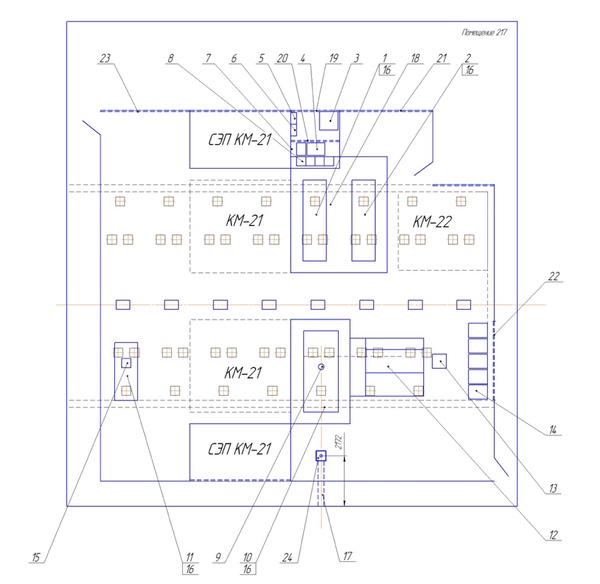
The recent Google Earth imagery indicates that after many years of delays the construction of Kalina is well underway. The telescope building and the tunnel connecting it to the lidar building are in place, but it is impossible to tell how much of the hardware inside has been installed. One clue that the system may still be some time away from reaching operational status comes in a biography of the chief designer of the electric drive mechanism (F-1090) for the telescope mount. The period of his involvement in the project is given as April 2021–September 2023.[19] The same person had already worked on F-1090 in 2012–2013, indicating that the work was resumed after a long hiatus. A possible setback for the project was the fact that NPTs Femto, the company that was tasked with building the adaptive optics system for Kalina in 2012, went into liquidation in July 2021. Kalina may also have been affected by the various economic sanctions imposed on Russia since 2014, more particularly those related to the import of electronic parts.
Other Russian laser weapons
Kalina is one of three laser dazzlers that Russia has designed to be used against satellites. An airborne system called Sokol-Eshelon has been under development since 2001, but it seems to have been on the verge of cancellation several times and its current status is unclear.[20] The only system known to be operational is Peresvet (internally known as Stuzha-RN or 14Ts034). This is a truck-mounted laser system that is co-deployed with mobile ICBM units and intended to prevent foreign reconnaissance satellites from following their movements.[21]
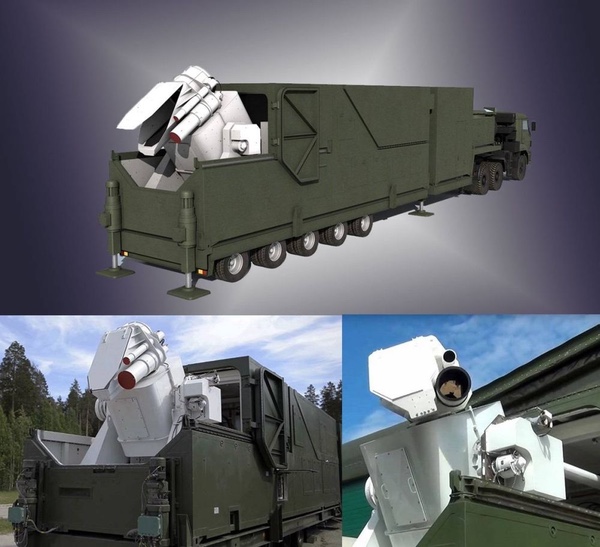
Peresvet’s anti-satellite role was recently confirmed in a presentation given by Yuri Borisov, Russia’s deputy prime minister for the defense industry. He said it can “blind” all reconnaissance satellites of “the likely adversary” up to an altitude of 1,500 kilometers, “disabling” them as they pass over Russian territory.[22] In literature on laser ASAT systems, a distinction is made between “dazzling” and “blinding”. Dazzling causes sensors to temporarily lose their imaging capability by swamping them with light that is brighter than what they are trying to image. Blinding inflicts permanent damage to such systems. Borisov’s wording would suggest that Peresvet is intended to do the latter, but perhaps his use of the verb should not be interpreted too literally.
Having designed three laser systems for similar purposes, Russia clearly attaches a great deal of importance to denying its enemies the opportunity to image its territory from space.
Peresvet was declared operational at five ICBM divisions in December 2019. Borisov said it is being “serially delivered” to the army, a possible sign that more have been deployed since. There are unconfirmed reports that two Russian military satellites launched in September 2021 and April 2022 (Kosmos-2551 and 2555) served as targets for Peresvet. Both were placed into very low orbits and re-entered just several weeks after launch without performing any maneuvers.
While Peresvet and Kalina have different prime contractors (RFYaTs-VNIIEF and NPK SPP respectively), there is at least some organizational connection between the two projects. The optics for both Kalina’s and Peresvet’s telescopes were developed by the same team at the Lytkarino Optical Glass Factory (LZOS). This can be determined from several issues of the company’s in-house magazine as well as a patent jointly written by specialists of LZOS and RFYaTs-VNIIEF. Peresvet’s telescope, which like Kalina’s is termed a “telescope-collimator”, has smaller mirrors, a 0.5-meter primary mirror and a 0.1-meter secondary mirror.[23]
Having designed three laser systems for similar purposes, Russia clearly attaches a great deal of importance to denying its enemies the opportunity to image its territory from space. Among the targets of these systems could not only be government-owned reconnaissance satellites but also the numerous commercial optical imaging satellites that are currently in orbit. Some of the theoretical foundations for the dazzling/blinding technique may have been laid by researchers at the Military Academy of the Strategic Rocket Forces in Balashikha near Moscow. Two of the Academy’s professors, Mikhail V. Sakharov and Viktor G. Sredin, have published numerous articles in the past 15 years or so on the effects of laser radiation on various types of imaging sensors, including those installed aboard remote sensing satellites. Officially, the research is aimed at studying how such sensors could be affected by satellite laser ranging systems, but there is good reason to believe that it also has other goals.[24]
Systems like Kalina, Peresvet, and Sokol-Eshelon are obviously ineffective against radar reconnaissance satellites, but Russia has at least two ground-based mobile electronic jamming systems (Krasukha-4 and Divnomorye) that are reportedly capable of interfering with the operation of such satellites.[25] Moreover, in 2020 a company named MAK Vympel was assigned to a project named Nast-R, which envisages the deployment of a network of electronic intelligence stations to analyze signals of foreign radar satellites, possibly with the aim of distorting the return signals.[26] Another company, Russian Space Systems (RKS), has been doing research on jamming data relay satellites (such as TDRS) in order to prevent them from relaying imagery of both optical and radar imaging satellites to ground stations. This work is possibly being done under a research project named Rasshireniye (“expansion”), assigned to RKS in May 2017. According to one court document, this focuses on developing satellite jammers that will benefit from experience already gained with a network of electronic warfare stations called Tobol or 14Ts227, which possibly target foreign navigation satellites.[27]
Besides dazzling or blinding optical sensors, lasers also have the potential of being used to physically destroy targets. During his recent presentation, Yuri Borisov revealed that Russia is working on more powerful laser systems than Peresvet capable of doing exactly that. He did not mention any for counterspace operations, but did single out Zadira, a mobile laser system to shoot down drones. In a subsequent interview for the Channel One television station, Borisov even claimed that Zadira was being used by Russian forces in Ukraine, but that cannot be independently verified. Zadira has the same prime contractor as Peresvet (RFYaTs-VNIIEF) and the two may therefore share common systems. Press reports on Borisov’s presentation claimed that virtually nothing is known about Zadira, but some of its design features are unveiled in an online PowerPoint presentation of NPP Advent, a subcontractor for the project. [28]
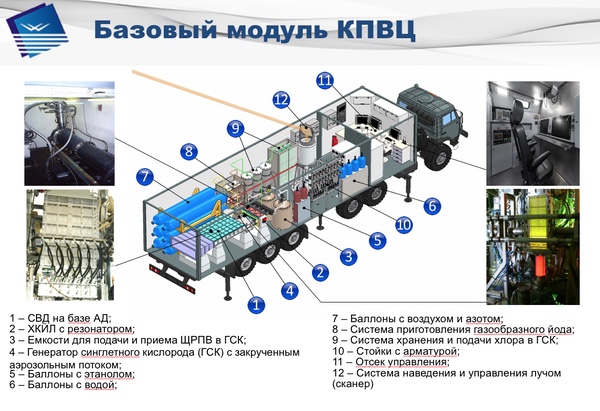
One possible way of disabling satellites with lasers is by employing the same techniques that have been studied for laser orbital debris removal (LDOR). The idea behind LDOR is to use laser energy to ablate a thin surface layer from a debris particle, forming a small plasma jet on the object that slightly slows it and eventually causes it to re-enter and burn up in the atmosphere. Laser orbital debris removal was studied by NASA in the 1990s under Project Orion, but was criticized for its potential anti-satellite applications. In 2018, NPK SPP proposed to test LDOR with the help of a new 3.12-meter telescope at the Titov Optical Laser Center in the Altai mountain range by connecting it to a solid-state laser of ITMO University. The new telescope, which nearly matches the capabilities of the Advanced Electro-Optical System (AEOS) operated by the US Air Force in Hawaii, has been under construction for many years, but does not appear to be operational yet.[29]
In literature on laser ASAT systems, a distinction is made between “dazzling” and “blinding”. Dazzling causes sensors to temporarily lose their imaging capability by swamping them with light that is brighter than what they are trying to image. Blinding inflicts permanent damage to such systems.
Finally, there are vague clues that Russia may be working on space-based laser systems. RFYaTs-VNIIEF has been the prime contractor since 2012 for a secretive project named Stan that seems to be aimed at outfitting various types of vehicles with lasers to defend them from enemy attack. Most of the limited information on Stan is related to a laser system that protects aircraft from missile attacks by confusing their infrared homing systems and appears to have been declared operational (the lead design bureau being NII Ekran.) However, Stan is also linked to a satellite defense system in an article published by the GLP Raduga laser test center. Other participants in Stan are RKK Energiya, PAO Saturn (a manufacturer of satellite batteries), and NPP Advent, one of the companies involved in Zadira. The space-based component of Stan would seem to be designed to protect satellites from ASAT attacks, but the line between defensive and offensive uses of such systems is obviously rather thin.[30]
It is also worth noting that NPP Advent has a role in Numizmat, a so-far unflown satellite of the Central Scientific Research Institute of Chemistry and Mechanics (TsNIIKhM) in Moscow, which specializes in counterspace systems. Known payloads for Numizmat are an ultra-wideband radar and a TV camera, probably to enable it to rendezvous with other satellites in orbit, but its true purpose remains a mystery.[31]
In addition to all this, Russia possesses conventional kinetic anti-satellite weapons. One of those, Nudol, destroyed a defunct Soviet-era satellite last November, producing a massive cloud of space debris that will pose a threat to low-orbiting satellites for many years to come. This showed that the Russians have few qualms about performing highly visible ASAT tests against actual targets in orbit, let alone covert tests with non-destructive counterspace systems like Kalina.
References
- The dates are seen in two procurement documents published in 2012 (1 and 2).
- Summary of a PhD thesis written by Yegor Kleimyonov in 2002.
- Bank guarantee document published in 2014 (only accessible in Russia).
- This document is no longer available online.
- NPK SPP’s annual report for 2013 (p. 47, 49, 51-52). Peresvet is managed by RFYaTs-VNIIEF, an organization under Rosatom. NPK SPP itself may also have a role in Peresvet. The report mentions the company’s involvement in two “special quantum-optical systems”, one Kalina and the other “Mobil”, possibly a cover name for Peresvet. A total of 10 to 12 “Mobil” units were expected to be delivered in 2020-2025.
- See, for instance, this court document published in 2019.
- Two procurement documents published in 2012 (1 and 2) ; Tender documentation published in November 2014; Article published in a newsletter of GLP Raduga in 2016 (p. 5).
- NPK SPP newsletter published in 2016, p. 1.
- See court documents published in 2017 and 2022.
- Tender documentation published in 2015.
- Patent published by NPK SPP in 2017; Article published by NPK SPP in 2022.
- Technical specifications for the adaptive optics systems are in this document. The assignment of NPTs Femto to its development is mentioned in this accompanying document. In late 2011 NPTs Femto was apparently also given a role in upgrading Krona’s existing lidar system with an adaptive optics system under a Roskosmos project named Dostavka, but it is unclear if this was completed. See NPK SPP’s annual report for 2013 (p. 47) and this tender documentation published in 2011.
- Tender documentation published in 2015.
- Articles published in LZOS in-house magazines in 2017 (p. 6) and 2019 (p. 59).
- Article published by LZOS researchers in 2016 (p. 26-28).
- Tender documentation published in 2018.
- Document published by NPK SPP in 2014.
- Tender documentation published in 2015.
- Biography of Valentin Tomasov on the ITMO website (see “Projects”).
- See this thread on Sokol-Eshelon on the NASA Spaceflight Forum.
- B. Hendrickx, Peresvet: a Russian mobile laser system to dazzle enemy satellites, The Space Review, June 15, 2020.
- Borisov’s presentation is online here (see 25:40-27:40 for his remarks on laser weapons, including Peresvet).
- Articles published in LZOS in-house magazines in 2014 (p. 5), 2017 (p. 6) and 2019 (p. 59) ; Patent published by LZOS in 2018. One of the authors (A.B. Smirnov) is an RFYaTs-VNIIEF specialist who co-authored another patent, known to be related to Peresvet.
- See, for instance, this article co-authored by Sakharov in 2020 (p. 2-6).
- B. Hendrickx, Russia gears up for electronic warfare in space (part 1), The Space Review, October 26, 2020.
- See this thread on Russian space surveillance systems on the NASA Spaceflight Forum (postings 4 and 5).
- Article on a data relay satellite jamming system published by Russian Space Systems in 2019 (full version available for registered users of elibrary.ru). This was co-authored by the chief designer of Tobol (Vladimir Vatutin). The Rasshireniye project is mentioned in this court document published in 2020.
- PowerPoint presentation of NPP Advent on a mobile laser system to shoot down drones. Zadira is not mentioned by name here, but NPP Advent’s involvement in Zadira is acknowledged in another PowerPoint presentation of the company here, where it is given as one of the projects that it worked on in 2014 and 2015 (p. 5).
- NPK SPP’s plans for the LDOR system are outlined in this PowerPoint presentation of NPK SPP (p. 20-22).
- See this thread on Stan on the NASA Spaceflight Forum.
- B. Hendrickx, Russia’s secret satellite builder, The Space Review, May 6, 2019 ; Numizmat is listed among the projects that NPP Advent worked on in 2014 in this PowerPoint presentation of NPP Advent (p. 5).
Fuente: https://www.thespacereview.com

